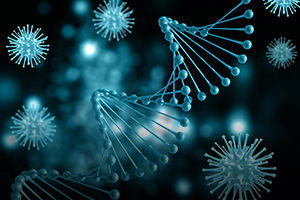Multiple Virus Vaccine
 As we all know, treating viruses is difficult because the same strain can mutate, making last year’s vaccines ineffective. And because different viruses are vastly dissimilar, creating a vaccine that combats multiple diseases seems like an impossible task. But a group of researchers has come up with a macromolecule that has the potential to treat several viruses by focusing not on what makes them different but what they have in common.
As we all know, treating viruses is difficult because the same strain can mutate, making last year’s vaccines ineffective. And because different viruses are vastly dissimilar, creating a vaccine that combats multiple diseases seems like an impossible task. But a group of researchers has come up with a macromolecule that has the potential to treat several viruses by focusing not on what makes them different but what they have in common.
Most antivirals target the RNA and DNA of the organism. Since this is the very thing that distinguishes each strain from others, this approach requires a different vaccine for each type of virus – and all of its mutations. The new macromolecule focuses instead on glycoproteins, which are present on the outside of all viruses and work to attach the cells to the body. Using electrostatic charges, the macromolecule attracts the virus toward itself and attaches to it, making it unable to attach to healthy cells. It then neutralizes the acidity levels in the virus, hindering its ability to replicate. Finally, the macromolecule enhances the body’s own immune response by attaching a sugar (called mannose) to the immune cells. This forces them closer to the virus, enabling them to be more effective at fighting it.
The treatment has been tested on Ebola and dengue with good results. Although further testing will be needed before it can be used as a treatment, the macromolecule represents a huge step toward the development of broad-spectrum antivirals.
For information: Yi Yan Yang, Institute of Bioengineering and Nanotechnology, 31 Biopolis Way, Singapore 138669; phone: +65-6824-7106; email: yyyang@ibn.a-star.edu.sg; website: http://www.ibn.a-star.edu.sg/